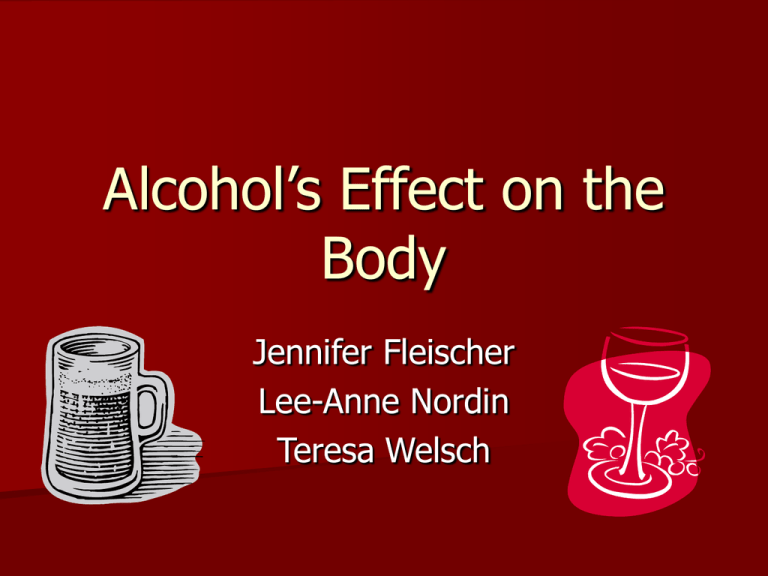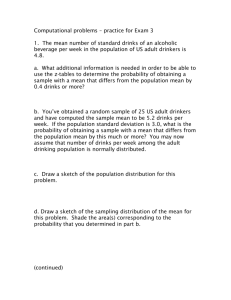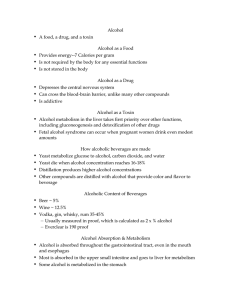Alcohol’s Effect on the Body Jennifer Fleischer Lee-Anne Nordin
advertisement

Alcohol’s Effect on the Body Jennifer Fleischer Lee-Anne Nordin Teresa Welsch What is an alcohol? Chemical terms = a class of organic compounds containing hydroxyl (OH) groups Common Terms = ethyl alcohol (ethanol) = intoxicating ingredient in beer, wine and distilled spirits (hard liquor) DRUG H H-C-H H-C-H OH Characteristics of alcohol Can dissolve lipids out of cell membranes = fast cell penetration, destroys and kills cells Kills microbial cells = disinfectants Toxic in relatively small doses (ethanol less so) Modifies body functions = a drug Potentially toxic and cannot be stored in the body Alcoholic Beverages Stated in proofs 100 = 50% alcohol 80 = 40 % etc. A drink = ½ ounce of pure ethanol Moderate intake: Avg. male = 2 drinks / day Avg. female = 1 drink / day Alcohol in the Body Does not need time for digestion Quickly absorbed On a full stomach the effects are delayed Always receives priority status and attention when present in the body Breakdown Begins in stomach – alcohol dehydrogenase enzyme Capillaries of digestive tract merge to veins and carry alcohol to liver *Goal is to get out of body as quickly as possible At the Liver – Veins make alcohols touch every liver cell – Liver cells = enough alcohol dehydrogenase to work fast enough to dispose of some alcohol before it moves on – Can process ½ (one drink) ounce per hour – #1 priority status = alcohol is metabolized before fatty acids and thus fatty acids accumulate Microsomal ethanol-oxidizing system (MOES) – Approx. 20% of alcohol consumed is handled by this system – Also used to break down other drugs (alcohol is still the #1 priority) 10% of alcohol leaves through breath and urine Alcohol dehydrogenase breakdown: 1. oxidizes to acetaldehyde 2.acetaldehyde dehydrogenase converts to acetate 3.converted to acetyl CoA These reactions produce H+ - Picked up by NAD to become NADH. Other processes such as energy are put on hold Excess NADH = lactic acid production = problems with excretion of uric acid and causes inflammation of joints. Stages of Liver Deterioration 1. 2. 3. Fatty Liver -difficulty generating glucose -interference of nutrient and oxygen distribution to liver cells. Fibrosis -liver cells die, forms fibrous scar tissue Cirrhosis -damage is least reversible at this point, regeneration is not likely Alcohol at the Brain Is a depressant NOT a stimulant – effects all nerve cells Brain cells die with excessive exposure (do not all regenerate) Depresses production of anti-diuretic hormone (ADH) which retains water = more urination & water loss Steps in which alcohol effects the Brain 1. Frontal lobe sedation (reason is impaired) 2. Speech and vision centers are sedated 3. Cells in cerebellum effected (coordination) 4. Respiration and heart action is effected Pros and Cons of Consumption Pros Reduced heart risk Reduce chances of coronary artery disease Stroke prevention Reduce development of blocked arteries in your legs Cons In small amounts… Slow brain activity Interfere with sleep and sexual function Raise your blood pressure Heartburn, headaches Binge Drinking Liver, Kidney, Lung and heart disease Stroke Osteoporosis Obesity Increase risk of types of cancer Short Term Effects of Alcohol (Lasts up to 72 hrs, Binge Drinking) The short-term effects on the circulatory system include decreased blood pressure, pulse and respiration. Alcohol blocks the absorption of essential nutrients and contributes to malnutrition among heavy drinkers. Alcohol use also impairs the functioning of the immune system— weakening the body’s ability to fight off infectious disease. In the short-term, this will increase the number of colds you will experience. Alcohol impairs memory by inhibiting the transfer and consolidation of information in long-term memory—so alcohol reduces our ability to remember information that we learned before going out for drinks. Short term cont… A person’s attention span is shorter for periods up to forty-eight hours after drinking Alcohol affects many parts of the brain, but the most vulnerable cells are those associated with memory, coordination, and judgment. May dull a person’s inhibitions Impair motor coordination, may stumble or fall May cause you to engage in unprotected, “regrettable” sex Long Term Effects of Alcoholism Arthritis Cancer- liver, pancreas, rectum, breast, mouth Fetal Alcohol Syndrome Heart Disease Hyperglycemia Hypoglycemia More effects… Infertility Kidney Disease Liver Disease Malnutrition Nervous Disorders Obesity Psychological disturbances Is two drinks too much? Alcohol is only destructive when consumed in large quantities on a continual basis. The body needs time to recover between episodes of drinking. Heavy drinkers have significantly greater risks of dying from all causes. Dietary Risks Study by Mendenhall, 1992 indicates that alcoholics are at risk for suffering from malnutrition, infections, and immune dysfunction. Malnourished patients are more likely to become ill. Alcoholics are more likely to be malnourished. Frequency and severity of malnutrition increased with the development of liver disease. Study found that malnutrition was proportional to socioeconomic status. More Dietary implications… Deitz et. al. 1996 Dietary implications are most devastating when alcohol consumption affects a person's ability to afford both alcohol and food or when alcohol replaces the preference or need for other important foods in the diet. Heavier drinkers were more likely to report a diet high in fat and low in fiber and to believe that diet has little effect on health. Specific Dietary Trends found by Deitz et. al. Heavier drinkers were 27 percent less likely than abstainers to consume sweets in 1987 and 32 percent less likely in 1992. In 1987 heavier drinkers were significantly more likely to consume more fatty foods compared with abstainers, and in 1992 light drinkers were less likely to consume fatty foods. Heavier drinkers were 22 percent less likely than abstainers to consume sweetened drinks in 1987 and 20 percent less likely in 1992. Moderate drinkers were 27 percent more likely than abstainers to eat salty snacks in 1987 and 39 percent more likely in 1992. Overall, heavier drinkers were nearly twice as likely to eat out (72 percent higher in 1987 and 70 percent higher in 1990) when compared with abstainers. Moderate and light drinkers were slightly more likely to take vitamin or mineral supplements compared with heavier drinkers in 1987. Data indicate that individuals who currently drank alcohol were more likely to supplement their diets with vitamins and/or minerals than were abstainers. Can Alcohol have Positive Effects? Ashley et. al. (2000) Evidence suggests that moderate consumption protects against ischemic stroke. (Tied to consumption of alcohol not specific beverages.) The evidence that moderate alcohol consumption protects against diabetes and gallstones is also fairly strong. May also have cognitive benefits but this is problematic because the effects of alcohol on the central nervous system are extremely complex, in part because alcohol interacts with many different neurotransmitter systems, and also because the effects on these systems may be dose-dependent and variable across individuals. Myths of Alcohol Alcohol is predominantly a sedative of depressant drug Alcohol has the same chemical and physiological effect on everyone who drinks Alcohol is harmful and poisonous to the Alcoholic Craving for alcohol can be offset by eating high sugar foods If Alcoholics eat three balanced meals a day, their nutritional problems will eventually correct themselves Alcohol stimulates the appetite Beer is a great source of carbohydrates, vitamins, minerals and fluids Drinking alcohol reduces the risk of heart disease If you take an aspirin before drinking, it decreases the odds of a hangover Facts More than 2 drinks daily doubles your chance of developing high blood pressure. 1 ½ drinks a day increases the risk of breast cancer. More than 1 or 2 drinks a week promotes aging. 1.5 million Americans are allergic to the ingredients in alcoholic beverages – without knowing it. Alcohol is the third leading source of calories in the American diet. Drinking poisons the heart muscles, counteracts the benefits of exercise, increases male impotence, and depresses the body’s immune system. The Drinker’s Prayer Our lager, Which art in barrels, Hallowed be thy drink. Thy will be drunk, (I will be drunk), At home as it is in the tavern. Give us this day our foamy head, And forgive us our spillage, As we forgive those who spill against us. And lead us not to incarceration, But deliver us from hangovers. For thine is the beer, the bitter, and the lager. Barmen Brothers...... References Alcohol and your health: Weighing the pros and cons. (August 27, 2002) CNN.com accessed June 12, 2004 [http://www.cnn.com/HEALTH/library/sc/00024.html] Ashley M.J. et. al. “Beyond ischemic heart disease: are there other health benefits from drinking alcohol?” Contemporary Drug Problems, (Winter 2000) v27 i4 p735 Deitz et. al. “Alcohol consumption and dietary practices in the U.S. population: 1987 and 1992.” Alcohol Health & Research World, (Spring 1996) v20 n2 p128(13) Luks, A. & Barbata, J. (1989) You are What you Drink: The Authoritative Report on What Alcohol Does to your Body, Mind, and Longevity. Villard Books, New York. Mendenhall , C. “Immunity, malnutrition, and alcohol.” Alcohol Health & Research World, (Wntr 1992) v16 n1 p23(5) Milam J. & Ketcham K. (1981) Under the Influence: A guide to the Myths and Realities of Alcoholism. Madrona Publishers, Seattle. Rimm E. B. et. al. “Review of moderate alcohol consumption and reduced risk of coronary heart disease: is the effect due to beer, wine, or spirits?” British Medical Journal, (March 23, 1996) v312 n7033 p731(6) Short Term Effects Sheet. (nd) accessed June 12, 2004 [http://mostdogs.truman.edu/effects_alcohol.htm] Whitney E. & Rolfes R. (2002) Understanding Nutrition. 9th eds. Wadsworth, Australia.


